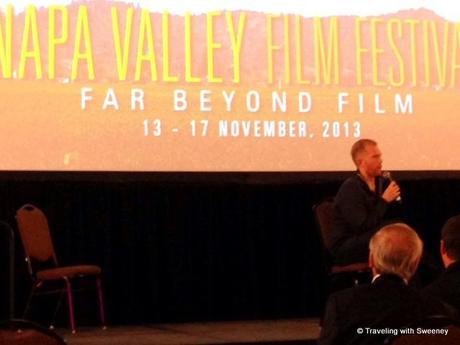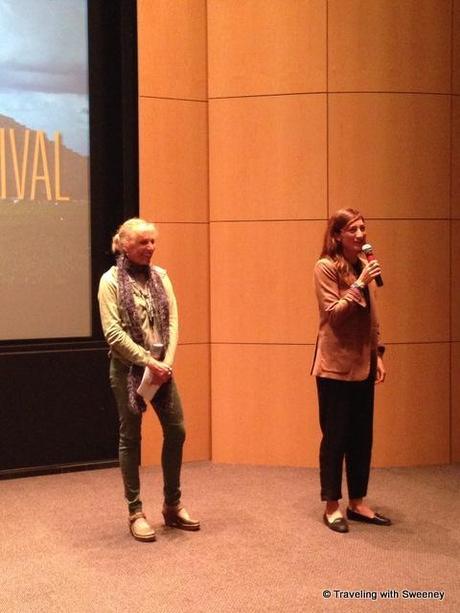Wine, camera, action!

Uptown Theater, Napa
Luscious wines and innovative independent movies in enticing venues on a gorgeous fall weekend in the Napa Valley? The Napa Valley Film Festival gets two thumbs up from my husband (“Mr. TWS”) and me!
As film buffs and wine enthusiasts with a special affection for Northern California wine country, Mr. TWS and I indulged our senses at the third annual (but our first) Napa Valley Film Festival, which ran from November 13 – 17, 2013.
Setting the scene
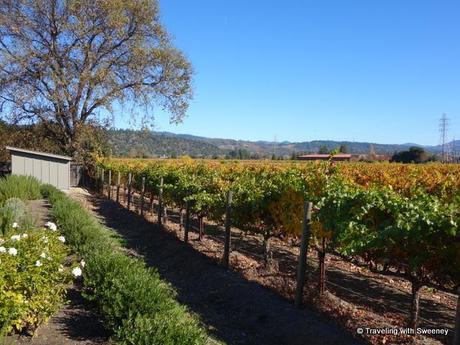
Napa Valley vineyards
Napa is beautiful any time of the year but the dates chosen by the festival seemed ideal. The vineyard leaves had turned yellow and red and there were many trees that seemed at just about peak color. Living just south of San Francisco we don’t get much of autumn colors or the feel of fall. Napa Valley in mid-November provided both in abundance.
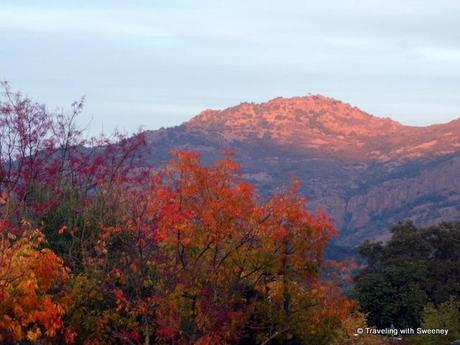
Sunshine on a Napa hilltop
The festival utilized theaters and other locations in four cities — Napa, St. Helena, Calistoga and Yountville, so we took advantage of the beautiful panoramas, hillsides and valleys with colorful vineyards and trees as we traveled between venues. And the weather couldn’t have been better with crisp mornings and evenings and warm, sunny days (about 70° F).
Setting the mood
The festival showcased 125 new independent films, 300 filmmakers, 50 chefs preparing VIP dinners and hosting culinary demonstrations, 150 wines in formal affairs and mix and mingles with film industry experts and celebrities in four Napa Valley towns, each having multiple film venues. Although the festival runs for a week, we only were able to participate on the weekend, but there was plenty to keep us entertained and interested. Prior commitments during the week precluded us from attending any of the celebrity tributes (Colin Farrell was there to accept his honor), red carpet events, sneak previews and premiers, such as Saving Mr. Banks, August: Osage County, Nebraska, The Immigrant, Philomena, Mandela: Long Walk to Freedom — which were given high marks by other festival-goers we chatted with over the weekend.
Being held in one of the world’s premier viticulture regions, wine was a key element alongside the cinematic features. During afternoon breaks in screenings between 2:30 and 5:30, wines were offered from various Napa vintners in each town’s designated wine pavilion near the screening locations. Selected wines were also served in the filming venues prior to showings. The atmosphere was always light, with friends and strangers alike sharing their film reviews and recommendations with those around them.
Locations
Calistoga
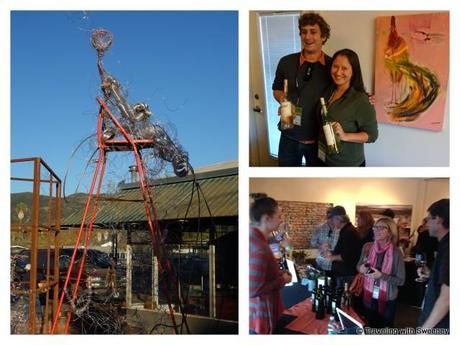
Calistoga wine pavilion – Top right: Joel Creager and Tara Katrina Hole, Bottom right: Amber Lanier and Dave Thompson
On the north end of the valley, Calistoga’s screening venue was in a former gliderport with a wine pavilion located at The Gallery at Indian Springs adjacent to it on Lincoln Avenue, the main street through town. Regional and boutique vintners of Calistoga wineries, including Frank Family Vineyard, Palisades Winery, Madrigal Vineyards, Jericho Canyon Vineyard, The Grade Cellars, Sterling Vineyards, Jax Vineyards and Envy Wines poured their varietals with backdrops of expressive art on the walls in a room adjacent to the main gallery. We had entertaining and infomration conversations with Amber Lanier of The Grade Cellars, Joel Creager of Madrigal Vineyards and Tara Katrina Hole of Jericho Canyon Vineyards while sampling their delicious signature Cabernets. We also enjoyed the company of our friend, Dave Thompson of The Napa Wine Project who was attending the festival.
Yountville
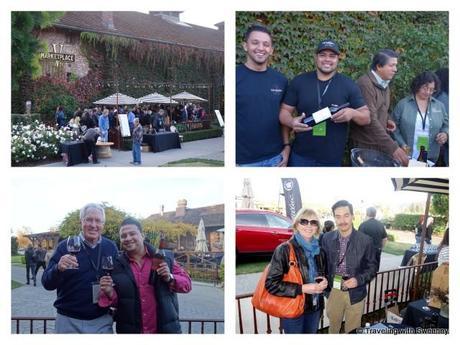
Yountville vine pavilion – Clockwise from top right: Puentes Family, Ignacio Delgadillo, Mr. TWS with Jaime Orozco of Mi Sueno Winery
For the film festival, Yountville had three screening venues and was the scene for A-Lister dinners, celebrity tributes and VIP after-parties among other key events. We watched a narrative feature, In Lieu of Flowers at the Yountville Community Center and then hopped across the street to the wine pavilion at V Wine Cellar where we mingled a bit with the film’s writer/director and cast members.
It was quite a lively scene at the NSMAVA Showcase wine pavilion at V Cellars where Mexican-American owned family wineries were talking about their wines and the wine-making history of their families in the valley. The wineries featured here were part of the Napa Sonoma Mexican-American Vintners Association, family run wineries including Honrama Cellars, Alex Sotelo Cellars, Ceja Vineyards, Encanto Vineyards, Delgadillo Cellars, Maldonado Vineyards, Mi Sueño Winery, Renteria Wines, Volcan Cellars, and Robledo Family Vineyards. As with many Napa wineries, Cabernet Sauvignon is a prominent varietal in these wineries, but each has their own methods and wine-making philosophies as we discussed with the winemakers. It was wonderful to listen to the younger generation of winemakers talk enthusiastically about their families’ long histories in the vineyards of Napa and the involvement of the family members in all aspects of the business. Juan Jose Puentes of Honrama Cellars explained the significance of the winery name honoring his father Honorio Ramirez Mata by using the starting letters of each of his names.
St. Helena
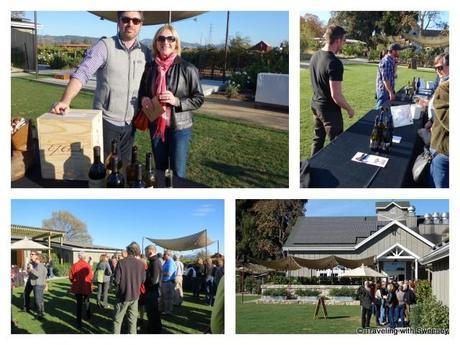
St. Helena wine pavilion, Top left: Dan O’Brien of Long Meadow Ranch Winery
On a beautiful fall day, this location was perfect for wine tasting outside on the lawn next to a large vineyard with the Napa hills in the background at Farmstead at Long Meadow Ranch Winery after a screening of The Girl on the Train. It was one of those moments when you just decide to bask in the good life of Napa wine country and savor the experience. We tried several wonderful wines from eight wineries in the NG (Next Generation) Winery group — Monticello Vineyards, Broman Cellars, Fisher Vineyards, Frazier Vineyards, Hill Family Estate Long Meadow Ranch, Signorello Estate, ZD Wines and Peju Province Winery. We met and talked to their representatives, often owners and family members. My favorite tastes were of ZD’s Chardonnay and Long Meadow Ranch’s EJ Church Reserve Cabernet.
Napa
Napa, on the southern end of the valley included much of the film action having five screening venues as well as late night parties, the festival gala and final awards ceremony. Two of the documentaries we watched were in Napa at the Cadillac Theater and historic Napa Valley Opera House (shown below). The Uptown Theater in the photo at the top of this article was location for the final night’s wrap party and awards ceremony. There were also many lodging options there, and we chose it as our base for the weekend.
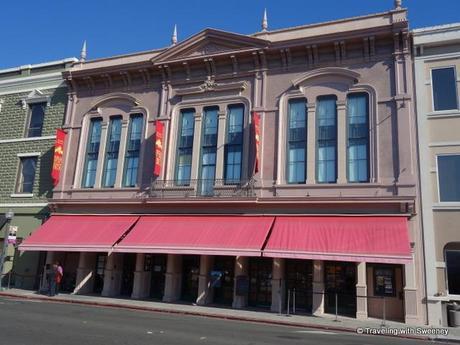
Napa Valley Opera House
Although we didn’t get to Napa’s wine pavilion that included many regional and boutique wines of Napa as well as the Women of the Vine wineries (alliance of top women winemakers and owners), we enjoyed a Jamieson Ranch Chardonnay prior to a documentary showing at the Cadillac Theater.
Showtime!
The hardest part of the weekend was figuring out what films to see from all of the choices, so we selected several that were a mix of narrative and documentary features. I’ve asked Mr. TWS to give you a quick recap of four of our favorite films of the weekend and what made the films and the festival special for him.
Mr. TWS:
I have loved movies since I was a kid. I love watching and talking about them. With our busy work and travel schedule this year, we’ve been off our usual number of movies so it was good to be able to have time dedicated to seeing movies at the festival. It gave us the opportunity to see a bit more diversity than we might seek out or have the opportunity to see in our normal movie experience with more independent films and documentaries, a few of which I’ve provided more detail below. There were also shorts and animated films that we didn’t have time to try. What was really the most fun were the discussions after the movies. Typically the person who was the real force behind each movie’s creation was there and spoke briefly before fielding questions.
In Lieu of Flowers
Writer/Director William Savage, In Lieu of Flowers
In Lieu of Flowers, a thought-provoking and emotional full-length film, explored the theme of grief around losing a loved one. The film explores the meeting and interaction of a young man and woman as they attempt to deal with their recent losses. Typically I would avoid a film that sounds this morose (although Sweeney likes such subjects), but I’m glad we didn’t.
The movie excellently balanced the grief with wonderful humor, scenes of New York and coincidences. The viewing was dramatically enhanced by the discussion afterward. Here we learned that the film was based partly on a real-life loss by the film’s writer and director, William Savage. I was amazed at his openness in discussing his personal experiences. I also realized that part of what made the discussions at this festival so good was the enthusiasm and intellect of the audience. This sentiment was echoed by the film representatives throughout our experience. One question led to a discussion of the distribution prospects for the film. Despite our enjoyment, I was surprised to hear that a theatrical release was an ultra-long shot and even alternatives, such as Netflix also faced long odds. Film fests such as this may be the only venue to see many of these films. A follow up question explored the film ending which was not a traditional Hollywood ending. After that discussion I was still surprised (though shouldn’t have been) to the answer about whether William thought about a more traditional ending to improve the film’s chances for distribution. His reply was that though he considered other endings, a more traditional one would have zero impact on distribution chances.
Another aspect of the film festival was the accessibility to the film principals. At the wine tasting in Yountville I introduced myself to William Savage. I was spurred by the fact that one of the questioners in the discussion had asked if he planned to do a cameo in all of his movies. I hadn’t noticed it and they didn’t identify the scene so I had to find out. I instantly recognized the scene and was really glad I got to meet him. As in the discussion, he was very open and appreciative of people’s interest in his film.
The Girl on the Train
Actress Nicki Aycox and Writer/Director Larry Bland, The Girl on the Train
We also saw The Girl on the Train, a nouveau noir film that had an interesting plot and even more interesting dialog which was elevated and poetic. We learned from writer/director Larry Bland and main actress Nicki Aycox, who had starred in several of his movies, that this is characteristic of Larry’s screenplays and that he has been referred to as a modern Shakespeare by one reviewer. The main character was a documentarian and an interesting vehicle in the film was the interspersing of scenes of his current life situation with those from the documentary he was making that involved a love story related by a Jewish man who had survived a Nazi concentration camp as a boy.
We really liked the film and were not surprised when it won the festival award for best screenplay, but my favorite part (as it was with all the movies) was the discussion afterward. The inspiration had been an actual real story and it was fascinating to learn why the idea was used and how the real story had been slightly altered in several ways. I also found it very interesting that Bland’s inspiration had been from more recent noir films — in particular Blood Simple, the Coen brothers’ first commercial film and one of my favorites. He also cited Tarantino, another of my favorites, and I could see why he may have been inspired to pursue unique dialog, though quite different than Tarantino’s. There were a number of twists so it was not surprising that Twilight Zone TV shows were also among his inspirations. The great noir films of the 30’s and 40’s,which I really like, were a lesser inspiration of his. We also like the New York setting, one of our favorite places. We love seeing movies set there.
American Jerusalem
There was a Jewish history aspect to three of the films that we saw — The Girl on the Train and two documentaries. We were attracted by American Jerusalem, a documentary about the early days of San Francisco and the Jewish people who played a significant role in its development from a small town of about 200 just before the California Gold Rush to one of the notable cities in North America by the turn of the century in 1900. They were also influential in the amazing recovery of the city after the 1906 earthquake, as San Francisco became a world destination by 1915 with the Panama-Pacific Exposition. I was amazed at how little I knew of the early San Francisco history. The significant impact that Jewish immigrants (most from Germany) had on the development of the city was unique and largely due to the fact that they were there from the beginning, on an equal footing with others moving west at that time — one of the themes of the documentary. Also interesting was the discussion of the altered Jewish religion that emerged as a result of their assimilation. The animation was also well done with intriguing animated still shots, an important aspect of the film since most of this history was prior to motion pictures.
March of the Living
Filmmaker Jessica Sanders (right) taking audience questions
A second documentary that enlightened us about a current day program, March of the Living was emotional and inspirational. The “March of the Living” is an annual program begun in 1988 to pass the torch of witness from the dwindling numbers of surviving Holocaust victims to next generations. The program has groups of teenagers from around the world each accompanied by a few survivors on a visit to the sites of Holocaust death camps in Poland. “When you listen to a witness, you become a witness,” is the thematic quotation from Elie Wiesel, Holocaust survivor, American author and activist, and Nobel Peace Prize winner of 1986.
This film chronicled the experience of a group from Los Angeles in 2008. Especially effective was the contrast of the introduction of several of the teenagers displaying typical teenage self-absorption and inexperience to their emotional awakenings in reaction to the sites and stories they witness on the two-week trip. Especially moving and inspiring were the stories of the victims and their reaction to revisiting the sites. The film captured the program’s annual finale in Poland on Holocaust Memorial Day (Yom HaShoah), when the participants silently retrace the death march from Auschwitz to Birkenau near the end of World War II. We were really pleased we saw this fine documentary by Jessica Sanders, Oscar nominated filmmaker and director.
Thanks for that, Mr. TWS!
That’s a wrap!
After a week filled with screenings, panel discussion, mixing and mingling with VIPs and filmgoers, the filmmakers, cast and crew are ready for the final night’s wrap party as they await to hear the winners of the festival announced. At the Uptown Theater in Napa, Rombauer wines ( I love their Chardonnay) and Stella Artois beers were being poured as everyone gathered in the auditorium.
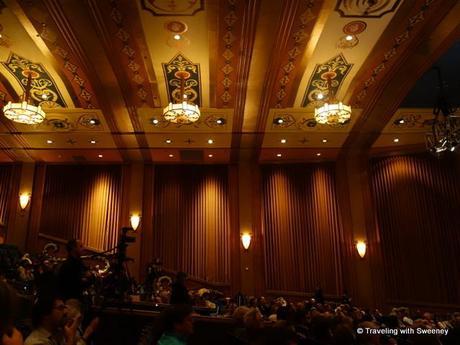
Inside the Uptown Theater for the wrap party and awards ceremony
The theater is beautiful; it had recently been restored to its original splendor. On stage, festival organizers, local influencers, members of the jury, and Napa vintners stood ready for the ceremony. Instead of a shiny trophy, the film festival winners received fine Napa wines presented to them by the vintners themselves.
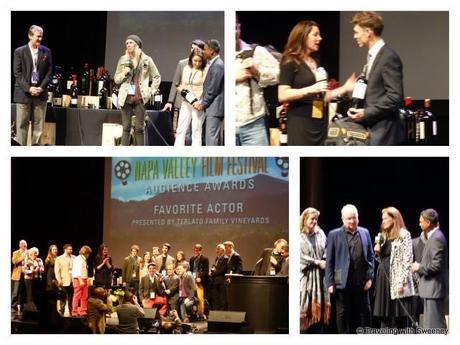
Awards Ceremony at Uptown Theater
It was a fast weekend that introduced us to some talented filmmakers and actors with their amazing independent films while enjoying the ambiance of the Napa Valley and delicious fruits of the vine!
For more information:
Full list of the 2013 Napa Valley Film Festival award winners
Napa Valley Film Festival 2014 – Plans are already in the works for next year’s event. I don’t know what will be in the pipeline of films that will be on the schedule, but it will debut November 12 – 16, 2014. There is a range of festival passes with a variety of admission options, special events, and perks. Day passes are also available.
This post originally appeared on Traveling With Sweeney.
